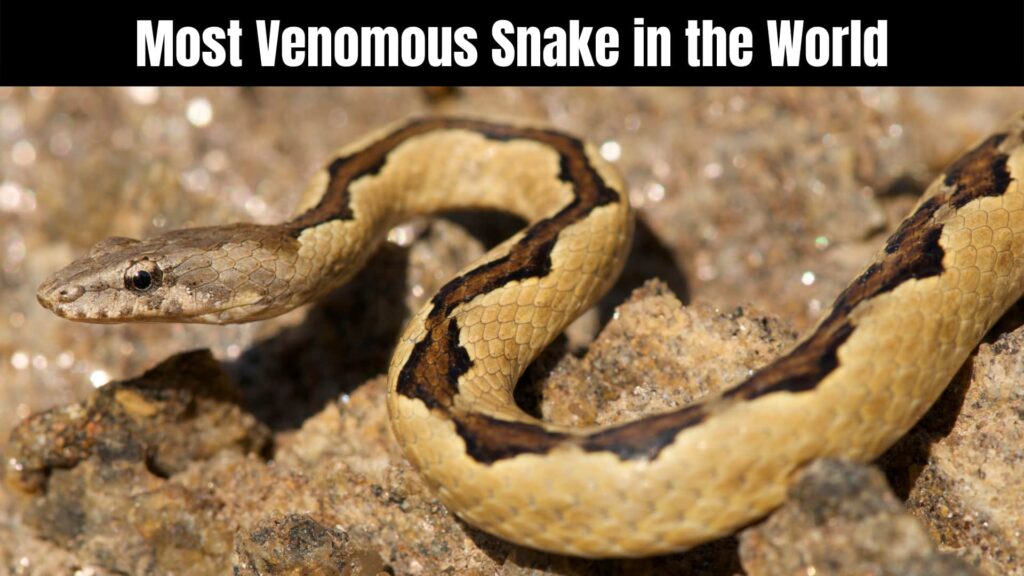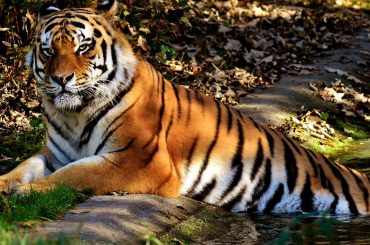Contents
- 1 What Is A Most Venomous Snake ?
- 2 Top 10 Most Venomous Snakes in The World
- 2.1 10. Most Venomous Snakes in the World – Philippine Cobra (Naja philippinensis)
- 2.2 09. Most Venomous Snakes in the World – Common Indian krait
- 2.3 08. Most Venomous Snakes in the World – Boomslang(Dispholidus typus)
- 2.4 07. Most Venomous Snakes in the World – Eastern Brown snake
- 2.5 06. Most Venomous Snakes in the World – Russell’s Vipers (Daboia russelii)
- 2.6 05. Most Venomous Snakes in the World – Black Mamba (Echis carinatus)
- 2.7 04. Most Venomous Snakes in the World – Inland Taipan (Oxyuranus microlepidotus)
- 2.8 03. Most Venomous Snakes in the World – Eastern Brown Snake (aka Common Brown Snake)
- 2.9 02. Most Venomous Snakes in the World – King Cobra (Ophiophagus Hannah)
- 2.10 01. Most Venomous Snakes in the World – Belcher’s Sea Snake (Hydrophis belcheri)
- 3 The Sidewinder Snake Slithers at 18 MPH [Video]
- 4 Summary

Do you want to learn about the 10 most venomous snakes in the world? According to the World Health Organization, there are over 600 venomous snake species on Earth, but only about 200 of them can cause serious harm to humans. By reading this article you will be able to know, 10 Most Venomous Snake in the World .
Also, you will able to know,
- What Is A Venomous Snake?
- Most Venomous Snakes in The World
- The Sidewinder Snake Slithers at 18 MPH [Video]
Let’s start,
Snakes with venom are among the most feared animals on the planet. This is because these snakes have venom that they can inject into their prey via specialized teeth. As a result, these venomous snakes are feared all over the World.
Venomous snakes come in over 600 different varieties. There are approximately 200 snake species that are capable of causing harm to humans. This accounts for less than 10% of all snakes on the planet.
Every year, 7,000 to 8,000 people in the United States are bitten by venomous snakes, but only 5 to 6 of these people die.
This list of the deadliest snakes includes the top 10 most venomous snakes. They are ranked from 10 to 01 based on the toxicity of their venom.
What Is A Most Venomous Snake ?
One of the most common misconceptions about venomous snakes is the distinction between venom and Poison. Venomous snakes use specialized teeth to inject venom into their prey. To have an effect, venom must be injected; Poison, on the other hand, must be swallowed.
Another common misconception is that snakes inject venom with each bite.
Snakes rely on venom to survive. It is used to assist them in hunting, feeding, and to defend themselves. According to the World Health Organization, dry bites account for half of all venomous snake bites. This means that when the snake bit, it did not inject any venom. There are three prominent families of venomous snakes:
1. Vipers are the most well-known
Rattlesnakes, Moccasins, and Copperheads are members of the Viperidae family. This family’s snakes are all venomous. The fangs in the front of the vipers’ mouths are pretty significant. When not in use, these fangs fold against the roof of the mouth.
2. Elapids are another family
This family includes coral snakes, cobras, kraits, sea snakes, and mambas. Elapids have shorter fixed fangs in the front of their mouths than viper fangs.
3. Colubrids is a family of venomous and non-venomous snakes
The Colubrid family includes many of our ‘backyard’ species, including Ratsnakes, Milksnakes, Kingsnakes, and Garter snakes. Short, inefficient fangs are common in venomous Colubrids. They cannot usually inject venom without chewing. Many Colubrids are not dangerous to humans.
Top 10 Most Venomous Snakes in The World
10. Most Venomous Snakes in the World – Philippine Cobra (Naja philippinensis)
Northern Philippine Cobras are highly venomous snakes from the far north of the Philippines and are known as the Northern Philippine Cobra. It is commonly found in the Philippines’ low-lying plains and forest regions, usually near freshwater sources.
The species is stocky, with a hood that can be raised when threatened. The snake is brown, with older snakes becoming lighter in color as they age. A cobra’s average length is about 3.3 feet, but some Philippine Cobras can grow as long as 5.2 feet. Size: 3.3 feet on average. Northern Philippines is the range of this species. This species’ conservation status is Near Threatened (Population Decreasing).
09. Most Venomous Snakes in the World – Common Indian krait
The standard Indian kraft can be found in India, Sri Lanka, Afghanistan, Bangladesh, and Nepal in various habitats. This snake, which is usually about three feet long, can grow to be six feet long. It can be found hiding in a hole or under a pile of rubble during the day. It transitions from being slow during the day to be highly active at night.
This snake is regarded as one of the four that kills the most people with its venom in India. When threatened, it bites and holds on, delivering far more venom than the average snake. Because the bite does not hurt, many people believe they are okay after being bitten by one. As a result, they do not seek immediate medical attention. Later, the person dies as a result of abdominal pains.
08. Most Venomous Snakes in the World – Boomslang(Dispholidus typus)
Boomslang is a venomous snake found in Sub-Saharan Africa that can grow 1.6 meters long and has a distinctive appearance, with big eyes in an egg-shaped head. Its name translates to “tree snake” in Afrikaans, and It hunts by imitating a branch by extending the forward part of its body from a tree motionlessly.
It has a highly potent venom that prevents blood coagulation and causes internal and external bleeding, ultimately killing the victim. When biting, the Poison is delivered through large fangs located in the back of the jaw, which can open to 170°.
The boomslang is a fearful snake that inflates its neck and strikes in an ‘S’ shape, but it only bites humans when they try to handle, catch, or kill it.
07. Most Venomous Snakes in the World – Eastern Brown snake
The Eastern brown snake is Australia’s most dangerous snake. This snake is hazardous because it lives in populated areas where mice can be found. It is typically between 6-and-13-inches long and highly aggressive. They frequently share their nests with other snakes, especially during the winter months. Male brown snakes often compete for the right to mate with a female. This nervous snake uses its bite more than most of Australia’s deadliest snakes, and it is responsible for the most significant number of snakebite fatalities.
06. Most Venomous Snakes in the World – Russell’s Vipers (Daboia russelii)
The Russell’s Viper, also known as the Chain Viper, is one of India’s most venomous snakes, with a bite resulting in severe bleeding. Unfortunately, this also makes it one of India’s most dangerous snakes, with the highest number of snakebite incidents and deaths among all venomous snakes. These snakes can measure 1,5 meters and have a deep yellow, tan or brown color, with the body’s length ranging from dark brown spots (each with a black ring around it).
These snakes are solitary reptiles that hunt primarily at night. However, they are known to become more active during the day in cooler weather. While they move slowly and sluggishly, they can become highly aggressive when threatened, making them extremely dangerous snakes. These snakes primarily feed on rodents, eat small reptiles, land crabs, scorpions, and other anthropods. This venomous snake’s young mostly hunt lizards, but they specialize in hunting rodents as they mature. They live in India, Sri Lanka, Bangladesh, Nepal, Myanmar, Thailand, Pakistan, Cambodia, China, Taiwan, and Indonesia.
These snakes are powerful and can react violently when picked up, which is why they are known as the World’s most dangerous snakes. They will either bite and release or hold on for a long time. In doses of 40–70 milligrams, their venom is highly lethal to humans. Excessive bleeding (especially in the gums and urine), A bite can cause a sharp drop in blood pressure and heart rate, as well as blistering, necrosis, vomiting, facial swelling, kidney failure, and blood clotting. A bite can also cause significant tissue damage, with pituitary gland damage affecting approximately 29% of survivors.
05. Most Venomous Snakes in the World – Black Mamba (Echis carinatus)
The black mamba is one of two snakes on this list that live in Africa (precisely, the dry bushlands of Eastern Africa), where it uses its speed to catch prey and inject an extremely toxic venom. Although it is frequently regarded as the fastest snake in the World, it is beaten into second place by the sidewinder.
The black mamba is a slender, agile snake capable of reaching 19 km/h in short bursts on open ground. It can grow to be up to 4 meters long. The black mamba, like the sidewinder, uses lateral undulation to gain momentum by moving in an ‘S’ shape and pushing off objects in its path.
The black mamba’s combination of speed, venom, and aggressive attitude is what makes it such a feared snake throughout Africa – and, indeed, places it on the list of most dangerous animals in Africa. Mambas, like all snakes, try to avoid confrontation with humans, but if backed into a corner, they will gladly stand their ground and fight.
04. Most Venomous Snakes in the World – Inland Taipan (Oxyuranus microlepidotus)
The Inland Taipan, also known as the “fierce snake,” is one of the World’s most venomous snakes. A bite from this type of Taipan frequently paralyzes the victim’s nervous system and causes blood clots. One of three types of Taipans is the Inland Taipan (Coastal, Inland, and Central Ranges), and its color ranges from a rich, dark hue to a brownish light-green depending on the season. This Taipan variety grows to be 1.7 meters long and is smaller than the coastal variety.
These snakes are solitary creatures that prefer to be outside during the day. They are most active in the early morning and spend most of their time looking for food and basking in the sun; however, they can also be seen out in the afternoons on cooler days. Despite being a highly venomous and dangerous snake, the Inland Taipan is usually shy and prefers to avoid conflict. They will, however, defend themselves and strike if provoked, mishandled, or prevented from escaping, earning it a place on the list of the World’s deadliest snakes. Inland Taipans only eat mammals, primarily rodents such as the long-haired, plains rat, and the house mouse. They are native to Australia and can be found in the south, Queensland, and the Northern Territory.
Inland Taipan venom contains lipoxin, a complex mixture of neurotoxins, procoagulants, and mycotoxins that can impair breathing, cause hemorrhaging in blood vessels and tissues, and paralyze damaged muscles. Between two and six hours after being bitten, respiratory paralysis can occur.
03. Most Venomous Snakes in the World – Eastern Brown Snake (aka Common Brown Snake)
The solitary and fast-moving eastern brown snake is native to Eastern and Central Australia and Southern New Guinea, except for dense forests. They can grow up to 2 meters long, with a slender build and no distinction between the head and the neck. Although it is known as the eastern brown snake, it comes in various colors, ranging from pale brown to black, and has a creamy yellow underside.
It is the World’s second-most venomous land snake, responsible for approximately 60% of snakebite deaths in Australia. During an entire display, the snake’s head rises high off the ground, coiling into an ‘S’ shape to attack, frequently resulting in lethal bites to the victim’s upper thigh. The main effects of the venoms are on the circulatory system, causing hemorrhaging, cardiovascular collapse, and cardiac arrest.
02. Most Venomous Snakes in the World – King Cobra (Ophiophagus Hannah)
King Cobra is revered and worshiped in India, but it is also feared because it is one of its most venomous snakes. A King Cobra’s bite contains a massive amount of neurotoxins that cause paralysis. They are so frightening that they appear on almost every list of the World’s deadliest snakes. King Cobra is dark olive or brown snake with black bands, white and yellow crossbands, and cream or pale yellow undersides. A King Cobra can reach 3 to 4 meters, with blackheads and two crossbars near the snout and two behind the eyes. The body of a young cobra is gleaming black with narrow yellow bands.
Although King Cobra is timid and does not confront people, she is one of the most dangerous bunnies in the World when she is triggered. It is, however, very protective of its offspring. The only snake that builds a nest for its eggs and guards them until they hatch is the King Cobra. A female King Cobra is an unusually dedicated parent among snakes. They primarily consume other snakes (including venomous ones), but they also consume lizards, birds, and rodents when food is scarce.
King Cobras can be found in Bangladesh, Bhutan, Brunei, Cambodia, China, Hong Kong, India, Indonesia, Laos, Malaysia, Myanmar, Nepal, the Philippines, Singapore, Thailand, and Vietnam. The venom of the World’s longest venomous snake, the King Cobra, is so potent that it can kill an elephant in just a few hours and kill 50 to 60% of untreated human cases.
01. Most Venomous Snakes in the World – Belcher’s Sea Snake (Hydrophis belcheri)
The Faint-Banded Sea Snake, also known as the Belcher’s Sea Snake, is a highly venomous elapid snake. Despite its shy demeanor, the Belcher’s Sea Snake is the World’s most venomous snake. The snake is small, with a slender body and a yellow base with green crossbands.
It is common in the Indian Ocean and the Philippines, the Gulf of Thailand, the Solomon Islands, and Northwest Australia. It is commonly found near tropical reefs and can hold its breath for nearly eight hours before surfacing for air. According to current observations, the Belcher’s Sea Snake eats small fish and eel. Size range: 1.5–3.3 feet. Geographical Range: Primarily near the Indian Ocean’s tropical reefs, the Gulf of Thailand, New Guinea, Indonesia, and the Philippines’ coastline (with some specimens found off the coast of Australia and the Solomon Islands)
The Sidewinder Snake Slithers at 18 MPH [Video]
Summary
Venomous snakes are a highly complex subject.
Venom cannot only cause significant harm but also heal. However, some poisons are highly toxic to certain animal groups while having little effect on others.
It is critical to learn more about venomous snakes and their venoms and their effects and potential treatments.
Unfortunately, snakebites are a significant health concern in countries with less advanced healthcare facilities. Each year, the World Health Organization estimates that venomous snakes bite approximately five million people.
Please share this “Top 10 Most Venomous Snake in the World” article, with your friends.
Let’s meet on next article.
Until, You can read: Top 18 Most Dangerous Animals in the World




